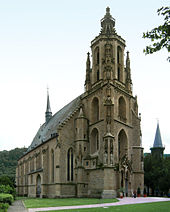Magdalena von Jülich-Kleve-Berg
Magdalena von Jülich-Kleve-Berg ( November 2, 1553 - August 30, 1633 ) was the third-born daughter of Duke Wilhelm the Rich of Jülich-Kleve-Berg and Maria von Habsburg , a daughter of Emperor Ferdinand I.
Life
Magdalena married Johann I, "the limping" , Count Palatine and Duke of Pfalz-Zweibrücken in 1579 . Since her brother, Duke Johann Wilhelm , died in 1609 without a male heir of his own, Wilhelm's daughters played a decisive role in the question of to whom the most important north-west German territory, Jülich-Kleve-Berg, should go to after Emperor Charles V granted the duchies the right of had granted female succession. Her husband Johann therefore raised Magdalena's claim to inheritance for the Duchy of Pfalz-Zweibrücken. The Brandenburg Elector Johann Sigismund, as the husband of Anna of Prussia , a daughter of Magdalena's eldest sister Marie Eleonore, who died in 1608, contested this claim with reference to a corresponding marriage contract from 1573, as did Philipp Ludwig von Pfalz-Neuburg , the husband of Magdalenas older sister Anna. In addition, the electorate of Saxony also claimed the duchies of Jülich-Kleve-Berg as the fourth party on the basis of a corresponding agreement with the emperor.

Since all the powers involved were involved in comprehensive European coalitions, and so Habsburg and France were also indirectly involved, an international conflict arose, the Jülich-Klevische Succession dispute, which , however, occurred in the Treaty of Xanten in 1614 after the death of the French King Henry IV (1610) could be provisionally settled. The administration of the disputed states divided between Brandenburg and Pfalz-Neuburg . Magdalena's husband had died in the meantime in 1604, his successor as Count Palatine was Magdalena's son Johann II , born in 1584 , the younger , who was not included in the Xanten Treaty. Their eldest child, their daughter Maria Elisabeth (1581–1637), married Georg Gustav , the Count Palatinate of Pfalz-Veldenz. The younger sons Friedrich Kasimir and Johann Kasimir became Count Palatine of Pfalz-Zweibrücken-Landsberg and Pfalz-Zweibrücken-Kleeburg. Magdalena was buried in the reformed castle church of Meisenheim .
Magdalenenbau
In the second residence, Meisenheim, of the Wittelsbach dukes of Pfalz-Zweibrücken, the so-called Magdalenenbau of the palace was built as a widow's residence . Only this building has basically been preserved from Meisenheim Castle despite severe damage. Landgrave Friedrich VI. von Hessen-Homburg and his wealthy wife Elisabeth Landgräfin von Hessen-Homburg chose Meisenheim as an additional summer residence from 1820 to 1829 and had the Magdalenenbau renovated and expanded with an additional neo-Gothic extension by the well-known architect and city planner Georg Moller . Today the building is known as the Herzog-Wolfgang-Haus.
literature
- Guido de Werd (Red.): Land at the center of powers. The duchies of Jülich, Kleve and Berg. 3. Edition. Boss, Kleve 1985, ISBN 3-922384-46-3 (exhibition catalog).
- Kurtzer founded and summary report / From the succession to the Gülischen Clevischen and Bergischen / also other belonging lands / principality / Graff: und rulers / [et] c. 1610, urn : nbn: de: hbz: 061: 1-77318
Web links
| personal data | |
|---|---|
| SURNAME | Magdalena von Jülich-Kleve-Berg |
| ALTERNATIVE NAMES | Jülich-Kleve-Berg, Duchess Magdalena von (full name) |
| BRIEF DESCRIPTION | Daughter of Duke Wilhelm of Jülich-Kleve-Berg and Countess Palatinate of Pfalz-Zweibrücken |
| DATE OF BIRTH | November 2, 1553 |
| DATE OF DEATH | August 30, 1633 |